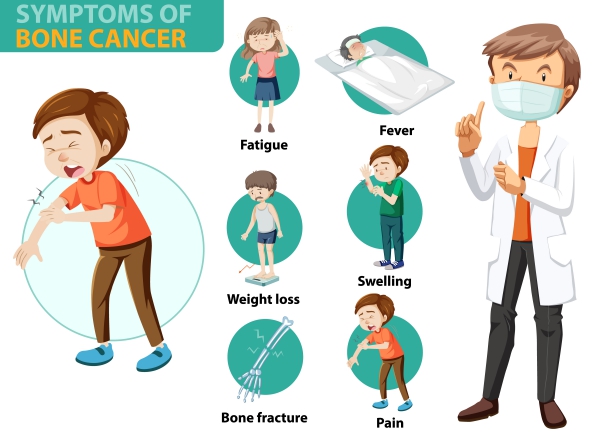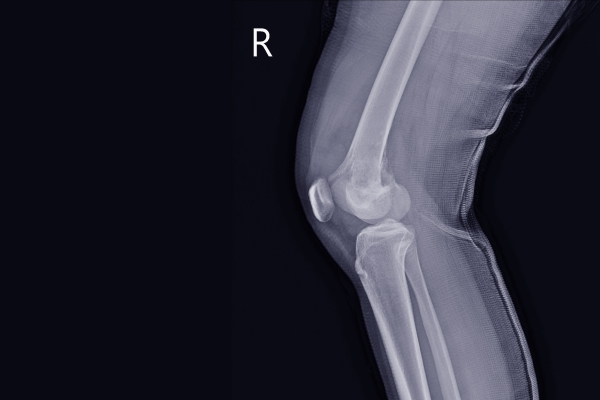What is osteosarcoma?
Osteosarcoma is a malignant (cancerous) tumour of the bone which is characterized by the production of immature bone (osteoid) by the malignant bone cells. It is the most common malignant bone tumour. It mainly affects the long bones found in the legs of children and teenagers.
In the United States, around 750-900 new cases are diagnosed annually. Osteosarcoma represents 56% of all bone cancers affecting people under the age of 20. In addition, it is more common in males than in females. Furthermore, it is more common in blacks compared to Caucasians.
The treatment of osteosarcoma comprises of surgery, chemotherapy and radiation therapy. The treatment chosen depends on the size of the tumour, number of tumours and whether the cancer has spread (metastasis) or not.
What are the causes and risk factors of osteosarcoma?
The exact cause of osteosarcoma is still unknown. However, it is known that this cancer occurs when there is something wrong with the cells that are responsible for producing new bones. Cancer cells are created when there is a defect or mutation in your DNA. This mutation causes these cells to multiply uncontrollably and lead to tumour formation. There are several factors which may increase your risk of developing osteosarcoma and these include:
- Sex: Males are more commonly affected by osteosarcoma than females.
- Race: Blacks are more at risk of developing osteosarcoma than Caucasians.
- Age: People under the age of 20 are more at risk of developing this type of cancer.
- Previous radiation therapy
- Previous chemotherapy
- Suffering from other conditions: Paget’s disease and fibrous dysplasia have been associated with a higher risk of developing osteosarcoma.
- Inherited conditions: Suffering from inherited diseases such as Li-Fraumeni syndrome, Rothmund-Thompson syndrome, Werner syndrome and hereditary retinoblastoma, increases your risk of developing osteosarcoma.

What are the signs and symptoms of osteosarcoma?
The symptoms of osteosarcoma usually occur for weeks or months before the diagnosis is made. The signs and symptoms of osteosarcoma include:
- Joint or bone pain: The most common symptom experienced by people suffering from osteosarcoma is joint or bone pain that increases with physical activity.
- Swelling of the affected joint or bone: Swelling of the joint or bone may be apparent which indicates the presence of a tumour. This mass may be tender and warm.
- Decreased range of motion of the affected joint.

Making a diagnosis

To make a diagnosis, your doctor will first take a detailed history from you to know more about your symptoms. After the history taking, your doctor will perform a thorough physical examination to look for signs of osteosarcoma. Your doctor will order some test in order to confirm the diagnosis and these include:
- Alkaline phosphatase (ALP): An elevated ALP level may indicate that the cancer has spread to your lungs.
- Plain radiography: X-ray of the affected one is taken to assess the bone. The tumour has as a “sunburst” appearance on x-rays.
- Bone scanning: Radionuclide bone scanning with technetium-99 is importance to assess whether the cancer is spreading or not.
- Computed Tomography (CT) scan: A CT scan of the affected bone and of the chest is taken to determine the exact location of the tumour, the extent of the tumour and whether the cancer is spreading or not. A CT scan of the chest is more accurate than a plain chest x-ray to determine the presence of metastasis.
- Magnetic Resonance Imaging (MRI) scan: The MRI scan of the bone is the best imaging technique in determining the extent of the tumour. It is also very important to obtain in the preoperative stage in order to evaluate the response of the tumour to neoadjuvant chemotherapy.
- Biopsy: This involves your doctor taking a sample of the tumour to be examined under the microscope. This is helpful to confirm the diagnosis and the grade the cancer. This procedure can either be done by the use of a needle or through a surgical procedure where either a piece of the tumour is removed or the entire tumour is excised.

There are some other tests which your doctor may order to assess your organ functions prior to the use of chemotherapy and these include:
- Lactic dehydrogenase (LDH)
- Complete blood count (CBC)
- Platelet count
- Liver function tests (LFT) which include aspartate aminotransferase (AST), alanine aminotransferase (ALT), bilirubin and albumin (a protein made exclusively by the liver).
- Electrolyte levels which include sodium, potassium, chloride, bicarbonate, calcium, magnesium and phosphorus.
- Renal function tests which include blood urea nitrogen (BUN) and creatinine level.
- Urinalysis
What are the treatments of osteosarcoma?
The treatment options of osteosarcoma include:
- Surgery: Surgery is done in an attempt to remove all cancer cells. The extent of the surgery depends on the size and severity of the tumour. There are mainly 2 types of surgeries which can be done including limb-sparring surgery and amputation. During a limb-sparring surgery, the cancer cells are removed and the functions of the limb is sparred. Most of osteosarcoma surgeries are done in this way. Amputation is rarely done nowadays due to the advancement in the medical field. However, if need be, when the limb is amputated, a prosthetic graft is used to improve outcomes and function.
- Chemotherapy: Chemotherapy is the use of drugs to kill cancer cells. When chemotherapy is used before surgery, it is known as neoadjuvant chemotherapy and it is done to reduce the size of the tumour. If the tumour shrinks, then a limb-sparring surgery can be performed. Unfortunately, if the tumour does not respond to neoadjuvant chemotherapy, a more aggressive form of surgery or a different combination of chemotherapy drugs will have to be used. In addition, chemotherapy can also be used after surgery to kill the remaining cancer cells.
- Radiation therapy: Radiation therapy is used in cases where surgery is not an option or when your surgeon cannot remove all cancer cells. This therapy uses high energy beams to kill cancer cells.

What are the complications of osteosarcoma?
If osteosarcoma is left untreated, the following complications may ensue:
- Metastasis: This is when the cancer spreads to other parts of the body. The most common locations to which the cancer can spread are the lungs and other bones.
- Side effects of chemotherapy: Being on chemotherapy can result in side effects such as hair loss, anaemia, easy bruising, loss of appetite, fatigue and infections amongst others.
Prognosis
The prognosis of osteosarcoma depends on the size and severity of the tumour. In addition, the presence of metastasis, significantly reduces the prognosis. The 5-year survival rate for people under 25 years is 61.6%. As your age increases, the 5-year survival rate decreases. Seeking medical advice early significantly improves the prognosis and prevent the onset of complications.

Source:
J. Alastair, I. and Simon, M., 2016. Davidson's Essentials of Medicine. 2nd ed. London: ELSEVIER.
Parveen, K. and Michael, C., 2017. Kumar & Clarks Clinical Medicine. 9th ed. The Netherlands: ELSEVIER.
Wang, L., 2020. Osteosarcoma: Epidemiology, Pathogenesis, Clinical Presentation, Diagnosis, And Histology.
Mehlman, C., 2020. Osteosarcoma: Background, Pathophysiology, Etiology.
Mehlman, C., 2020. Osteosarcoma Workup: Laboratory Studies, Imaging Studies, Other Tests.
Mehlman, C., 2020. Osteosarcoma Treatment & Management: Approach Considerations, Medical Therapy, Biopsy.
Janeway, K., 2020. Chemotherapy And Radiation Therapy In The Management Of Osteosarcoma.









